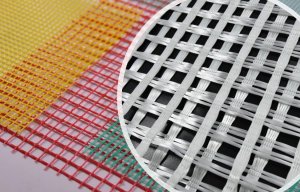
Rethinking civil engineering at ITM
Karl Mayer Malimo has developed a new range of geogrids with load-bearing capacities which it says have never been achieved before. The innovative textiles have a tensile strength of 1000 kN in both the weft and zero inlay directions.
23rd August 2012
Innovation in Textiles
|
Chemnitz
Karl Mayer Malimo has developed a new range of geogrids with load-bearing capacities which it says have never been achieved before. The innovative textiles have a tensile strength of 1000 kN in both the weft and zero inlay directions.
Geogrids are good all-round materials used in the construction sector. They are used to separate adjacent types of ground, remove solid components when used as filters, absorb liquids over a wide area, prevent soil erosion and provide mechanical protection.
Another important use is in soil stabilisation, e.g. in road building, laying railway tracks, bridge building and also for constructing dams and dykes, and these are just some of their applications. Geogrids are used as a special type of geotextile for use in reinforcement applications.
Depending on their end-use, geogrids have openings of different size, and distribute static and dynamic loads over a wide area into the subsoil. The RS MSUS-V raschel machine with parallel weft insertion and the facility to feed-in webs has become an established feature of the market for producing strong reinforcing textiles.
Karl Mayer Malimo supplies this machine, which has secured its position on the market, thanks to the new products that are being developed all the time. The latest innovation in geogrids is a super-strong type for use in applications such as mining.
The new geogrids developed by Karl Mayer have a tensile strength of 1000 kN in both the weft and zero inlay directions and it is possible to demonstrate this characteristic.
Test standard DIN EN ISO 10319 was used to test this mechanical parameter. Other features of these extremely strong geogrids include a raw fabric weight of 3300 gsm, a construction consisting of high-strength polyester in the weft and zero inlay directions, and a flame-resistant coating.
With this performance profile, the new products manufactured on the RS MSUS-V have opened up a market in the mineral mining industry. In the mining sector, they are used to stabilise the roof and side walls to protect personnel and machinery from rock falls and stones.
Karl Mayer Malimo says the main sales regions are China and Russia, but other countries are also showing an increasing interest.
Karl Mayer Malimo’s product developers used an RS MSUS-V in gauge E 3 and a working width of 213 inches to produce the new geogrids. This machine is said to be extremely flexible and can process glass rovings and basalt, as well as every count of polyester, and can also produce a wide range of different constructions.
A big advantage in terms of the flexibility is that webs can also be fed in. This innovative, sturdy raschel machine can incorporate layers of webs to produce composites in a single step, without requiring any additional time and effort (Fig. 3).
Direction-oriented reinforcing yarns in the textile composites provide a tear strength that can be specified precisely to suit the end-use. They are responsible for support and reinforcement, while the webs provide erosion protection, separation and filtration.

Business intelligence for the fibre, textiles and apparel industries: technologies, innovations, markets, investments, trade policy, sourcing, strategy...
Find out more